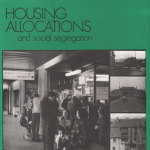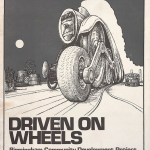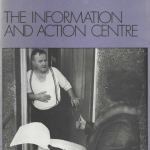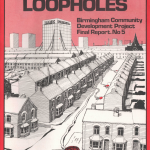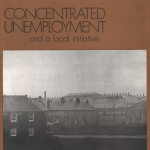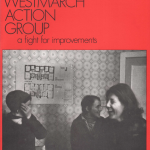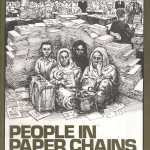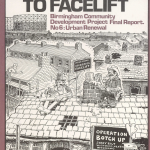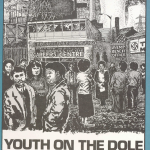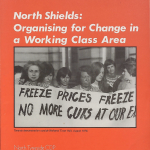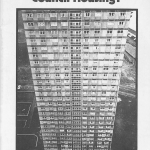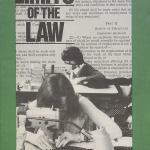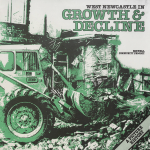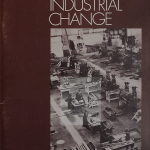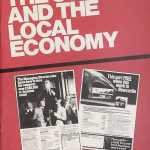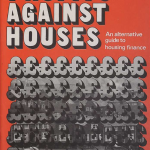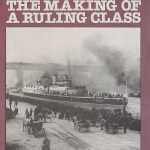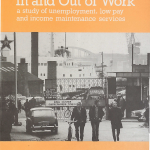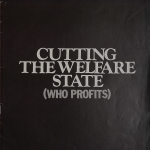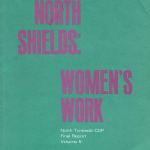Below are some notes for something I’m writing but have decided not to use, mainly because I’m relying too heavily on Postone’s extensive though singular critique of Habermas. I originally wrote it reflecting on the ‘Seven principles towards a strategy for scholar activism’ as set out by The Autonomous Geographies Collective. One of the principles (#4) is ‘Be aware of our own action research footprint’ and it got me thinking about my work on the SSC as ‘action research’. What interests me is that Kemmis, one of the main theorists of action research, is grounding the latest development of his theory in the ‘communicative action’ of Habermas, who Moishe Postone pulls apart through his reading of Marx. So there’s something to be worked out here if ‘action research’ informed by critical theory, is used to describe aspects of my own research.
I want to reflect on the Social Science Centre as an ‘action research’ project, conscious that while it is beyond the university, it has been and continues to be a persistent and ever present part of my research inside the University of Lincoln. As such, the SSC might be understood to form part of my ‘action research footprint’ according to the broad definition given by Carr and Kemmis.
“Action research is simply a form of self-reflective enquiry undertaken by participants in social situations in order to improve the rationality and justice of their own practices, their understanding of these practices, and the situations in which the practices are carried out.” (Carr and Kemmis 1986: 162)
Although we have never collectively defined our work as action research, members of the SSC are continuously engaged in the type of ‘self-reflective enquiry’ described by Carr and Kemmis, not with the aim of producing a ‘research outcome’ but so as “to improve the rationality and justice of [our] own practices, [our] understanding of these practices, and the situations in which the practices are carried out”. For myself, it is a form of “prefigurative practice” understood in the way that I discuss in Winn (2015) and also accords with the sixth principle of scholar activism of ‘being the change we want to see’. Yet the fourth and six principles of scholar activism listed above are not adequately developed to correctly convey the way I conceive the Social Science Centre: it is action research by default not by design; it is prefigurative practice but grounded in a negative critique; but neither is it, for me, the practice of resistance.
As with our pedagogical approach, the SSC as a ‘participatory action research project’ is informed by a critique of the contradictory relationship between labour and capital and the emancipatory potential inherent in the commodity-producing form of labour. From this position, labour is understood dialectically as both socially constituted and mediating (Postone, 1993) and so the ‘methods’ of our ‘research’ are understood to be constituted by our immanent social conditions as well as prefigurative of the emancipatory potential of our collective work. There is no place outside the totality of capital and its determinate social forms.
In terms of being ‘critical, participatory action research’, the Social Science Centre aligns with Kemmis’ recent definition (2008). Critical participatory action research is:
- Participatory and collective research to achieve effective historical consciousness in and of practice as praxis
- Research for critical (self-) reflection
- Research that opens communicative space
- Research to transform reality
- Research with a practical aim
- Research with emancipatory aims
No-one would deny the importance of needing a safe communicative space – indeed the SSC is just that – yet Kemmis’ definition draws heavily from Habermas’ theory of ‘communicative action’ which is achieved through the ‘intersubjective’ social relations of the project’s participants. For Habermas, intersubjectivity is linguistically grounded:
“As historical and social beings we find ourselves always already in a linguistically structured life world. In the forms of communication through which we reach an understanding with one another about something in the world and about ourselves, we encounter a transcending power.” (Habermas quoted in Kemmis, 2008, 128)
From this standpoint, Kemmis defines ‘critical’ in terms of “the quality of the argument, and the ways people participate in it.” (129) Thus critical participatory action research is ultimately reduced to “the conversation”, which is “all we have and all we will ever have”. (129) Unfortunately, this is a mystifying and pessimistic theory of action, derived from a transhistorical conception of subjectivity, which uproots the possibility of emancipation from any historical and material reality. As Postone (1993) has argued, Habermas’ theory of communicative action (and therefore any derivative theory such as Kemmis’), has replaced Marx’s historically specific, socially constituting category of labour in capitalism with a transhistorical theory of communication.
According to Postone, Habermas understands labour only in a technical sense as ‘instrumental action’ and argues that a theory of knowledge that rests on such a category of labour is an instrumentalist theory of knowledge. (1993, 228) In my own work, I have discussed at length Marx’s theory of labour, referring to Marx’s original work as well as that of Postone’s interpretation. It seems that Habermas understands labour not as having a double concrete and abstract character, but is simply concrete labour. As Postone has shown, this has been a common misunderstanding since Marx’s time which has affected the tradition of Critical Theory from Horkheimer to Habermas. Whereas Marx and consequently Postone offer a theory of social constitution, mediation and synthesis through the double form of labour, Habermas looks elsewhere, to a theory of linguistics, to explain the interaction among humans and between humans and nature. Postone makes clear the implications of such an approach:
“If the process of social constitution by labor does indeed specify capitalism, then to project this mode of constitution transhistorically (as traditional Marxism has), or to replace it with an equally transhistorical scheme of the existence of two separate but interdependent spheres (labor and interaction, instrumental and communicative action) is to obscure the specificity of commodity-determined labor and, hence, of what characterizes capitalism. More generally, the methodological and epistemological implications of Marx’s categorial analysis of capitalism raise serious questions about any attempt to develop a social theory on the basis of a set of categories presumed to be applicable generally to the history of the human species.” (1993, 231-2)
Postone argues that Habermas has misunderstood Marx’s labour theory of value and the crucial distinction between material wealth and value as a form of social wealth derived from the corresponding dual categories of concrete and abstract labour. Marx’s labour theory of value is not simply a theory of the instrumentality of economics but a theory of emancipation which shows how the productive capacity and potential of labour in capitalism contains the possibility of its own overcoming. Although capitalism is a totalizing system of social relations, it is fundamentally based on the inherent contradiction in commodity producing labour, giving rise to the possibility of critique and emancipation.
Habermas reads Marx’s labour theory of value as one of historical evolution rather than historically specific to capitalism and sees labour as a technical activity rather than a socially constituting and mediating category. Contrary to this, Postone’s reading of Marx shows that the dual character of commodity-determined labour is a historically specific mode of social constitution which “underlies the automatic regulation of social life in capitalism.” (236) Postone argues that Habermas identifies ‘communicative action’ as existing apart from the realm of capitalism through which critique is made possible:
“as a result, the critique apprehends capitalism only as pathological and, therefore, must ground itself in a quasi-ontological manner, outside of the social and historical specificity of this form of social life.” (Postone, 1993, 153)
What this points to is that unlike Kemmis’ conclusion that “the conversation” is “all we have and all we will ever have”, Postone argues that labour, or rather the critique of labour, provides the groundwork for an emancipatory theory of knowledge, action and praxis. Participatory action research with emancipatory intent is not so much a case of being ‘critical’ as Kemmis defines it in relation to the “the quality of the argument, and the ways people participate in it” but, rather, all about pursuing a negative critique of and through that which is historically, socially and therefore epistemologically constituting and mediating in capitalism: labour.
This is not a theory of resistance or opposition as such, but rather one that recognizes the immanent possibility generated by the totalizing system of domination itself. Capital’s relentless drive to replace living human labour with dead, alienated labour (machines) points to the abolition of labour (wage work) as the basis of emancipation. The possibility of reducing the socially necessary labour time required in producing value as the form of social wealth is itself evidence that “Capital thus works towards its own dissolution as the form dominating production.” (Grundrisse, 700)
Postone shows that an evolutionary theory of intersubjectivity is ultimately restorative of the standpoint of labour as socially constituting and mediating and does not provide the basis of a negative critique of labour which points towards its abolition or overcoming. Emancipatory theories such as Habermas’ theory of communicative action which are set against and somehow outside capital are ultimately theories of resistance to capital and blind to the emancipatory potential inherent in the contradictions of capital. Critical participatory action research as theorised by Kemmis may appear dynamic and dialogical on the surface but its weakness is that it is grounded in a transhistorical, one-dimensional theory of opposition that can offer little more than ameliorative social reform and therefore denies the possibility of what could be, in favour of what is. Conceived as such, it is neither prefigurative nor does it offer participants a standpoint that is immanent to the object of critique.
In my article, Writing about academic labour, I concluded by drawing on Postone’s assertion that ‘resistance’ as a form of action expresses “a deeply dualistic worldview that tends to reify both the system of domination and the idea of agency.” (Postone 2006, 108). It is “an expression of a deep and fundamental helplessness, conceptually as well as politically.” (Postone 2006, 102) Moreover, it is “an undialectical category that does not grasp its own conditions of possibility.” (2006, 108) Postone’s argument has had a profound affect on the way I view ‘scholar activism’ and reflect on my work on the Social Science Centre as a form of praxis. The key to understanding his argument here is that, as with Kemmis’ use of Habermas, action grounded upon a form of (inter-) subjectivity which views labour simply as the production of use-value, i.e. ‘concrete’, ‘natural’, ‘material’ wealth, is a “hypostatisation of the concrete”; it fetishises the concrete as a form of anti-capitalist resistance, inevitably leading to a sense of helplessness.
“The hypostatization of the concrete and the identification of capital with the manifest abstract underlie a form of “anticapitalism” that seeks to overcome the existing social order from a standpoint which actually remains intrinsic to that order”. (Postone 2003: 93)
This is the danger of a type of activism, framed as ‘action research’ or otherwise, which asserts a radical subjectivity outside the double character of labour. Although widespread, such action is based on a limited theoretical position which, as Neary and Amsler have argued, in practice
“perpetuates the approach it is attempting to critique … replicating and repeating struggles in more fragmented forms without posing a fundamental challenge.” (Neary & Amsler 2012: 119)
As an example of activism, the formation of the SSC was intended to be progressive within the limits of what was possible. It was not oppositional to the idea of the modern university only to what it had actually become. It was not borne out of helplessness but out of the crises produced by the capital labour relation, recognising that new models are needed that are more adequate to the crises we are experiencing. What is required then, for me at least, is to continue to develop my research in and on the SSC in such a way that it is constitutionally and pedagogically grounded in a particular understanding of academic labour and an academic commons, which recognises the constituting and mediating role of wage work and private property in all aspects of social life, not least higher education.

